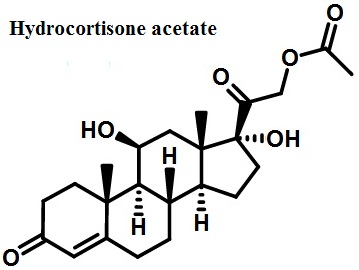| Identification | More | [Name]
Hydrocortisone acetate | [CAS]
50-03-3 | [Synonyms]
11BETA,17ALPHA,21-TRIHYDROXY-4-PREGNENE-3,20-DIONE 21-ACETATE
17-ALPHA-HYDROXYCORTICOSTERONE ACETATE
17-HYDROXYCORTICOSTERONE 21-ACETATE
17-HYDROXYCORTICOSTERONE ACETATE
21-acetoxy-4-pregnene-11b,17a-diol-3,20-dione
21-ACETOXY-4-PREGNENE-11BETA,17ALPHA,21-TRIOL-3,20-DIONE
21-ACETOXY-4-PREGNENE-11BETA,17ALPHA-DIOL-3,20-DIONE
4-PREGNEN-11-BETA, 17,21-TRIOL-3,20-DIONE 21-ACETATE
4-PREGNEN-11BETA,17ALPHA,21-TETROL-3,20-DIONE 21-ACETATE
4-PREGNENE-11BETA,17ALPHA,21-TRIOL-3,20-DIONE 21-ACETATE
ACETIC ACID 2-((8S,9S,10R,11S,13S,14S,17R)-11,17-DIHYDROXY-10,13-DIMETHYL-3-OXO-2,3,6,7,8,9,10,11,12,13,14,15,16,17-TETRADECAHYDRO-1H-CYCLOPENTA[A]PHENANTHREN-17-YL)-2-OXO-ETHYL ESTER
CORTISOL 21-ACETATE
CORTISOL ACETATE
DELTA4-PREGNEN-11BETA,17ALPHA-21-TRIOL-3,20-DIONE-ACETATE
HYDROCORTISONE 21-ACETATE
HYDROCORTISONE ACETATE
HYDROCORTISONI ACETAS
HYDROCORTONE ACETATE
LANACORT
(11beta)-21-(Acetoxy)-11,17,21-trihydroxypregna-1,4-diene-3,20-dione | [EINECS(EC#)]
200-004-4 | [Molecular Formula]
C23H32O6 | [MDL Number]
MFCD00037714 | [Molecular Weight]
404.5 | [MOL File]
50-03-3.mol |
| Chemical Properties | Back Directory | [Appearance]
white powder | [Melting point ]
223 °C (dec.)(lit.)
| [alpha ]
D25 +166° (c = 0.4 in dioxane); D25 +150.7° (c = 0.5 in acetone) | [Boiling point ]
446.1°C (rough estimate) | [density ]
d420 1.289 | [refractive index ]
1.4593 (estimate) | [Fp ]
223°C | [storage temp. ]
0-6°C | [solubility ]
Practically insoluble in water, slightly soluble in anhydrous ethanol and in methylene chloride | [form ]
Solid | [pka]
12.42±0.70(Predicted) | [color ]
White to Off-White | [Stability:]
Stable, but may be light or moisture sensitive. Incompatible with strong oxidizing agents. | [Water Solubility ]
Insoluble in water. | [Decomposition ]
223 ºC | [Usage]
Glucocorticoid | [Merck ]
14,4787 | [BRN ]
2066841 | [LogP]
2.190 | [CAS DataBase Reference]
50-03-3(CAS DataBase Reference) | [NIST Chemistry Reference]
Hydrocortisone acetate(50-03-3) |
| Safety Data | Back Directory | [Hazard Codes ]
Xn | [Risk Statements ]
R63:Possible risk of harm to the unborn child. | [Safety Statements ]
S36/37:Wear suitable protective clothing and gloves . | [WGK Germany ]
3
| [RTECS ]
GM8960000
| [HS Code ]
29372100 | [Toxicity]
LD50 intraperitoneal in mouse: 2300mg/kg |
| Hazard Information | Back Directory | [Chemical Properties]
white powder | [Definition]
ChEBI: Cortisol 21-acetate is a tertiary alpha-hydroxy ketone and a cortisol ester. | [Brand name]
Cortef
Acetate (Pharmacia & Upjohn); Cortifoam (Schwarz
Pharma); Cortril (Pfizer); Dricort (Ingram); Hydrocortone
(Merck). | [Clinical Use]
Corticosteroid:
Local inflammation of joints and soft tissue | [Drug interactions]
Potentially hazardous interactions with other drugs
Aldesleukin: avoid concomitant use.
Antibacterials: metabolism accelerated by rifampicin;
metabolism possibly inhibited by erythromycin;
concentration of isoniazid possibly reduced.
Anticoagulants: efficacy of coumarins and
phenindione may be altered.
Antiepileptics: metabolism accelerated by
carbamazepine, phenobarbital, fosphenytoin,
phenytoin and primidone.
Antifungals: increased risk of hypokalaemia with
amphotericin - avoid; metabolism possibly inhibited
by itraconazole and ketoconazole.
Antivirals: concentration possibly increased by
ritonavir.
Ciclosporin: rare reports of convulsions in patients
on ciclosporin and high-dose corticosteroids
.
Cobicistat: concentration of hydrocortisone possibly
increased - increased risk of adrenal suppression.
Diuretics: enhanced hypokalaemic effects of
acetazolamide, loop diuretics and thiazide diuretics.
Vaccines: high dose corticosteroids can impair
immune response to vaccines - avoid concomitant
use with live vaccines. | [Metabolism]
Hydrocortisone is metabolised in the liver and most
body tissues to hydrogenated and degraded forms such as
tetrahydrocortisone and tetrahydrocortisol.
These are excreted in the urine, mainly conjugated as
glucuronides, with a very small proportion of unchanged
hydrocortisone. | [Purification Methods]
The acetate recrystallises from Me2CO/Et2O or aqueous Me2CO as hygroscopic monoclinic crystals. UV has max at 242 nm (A1cm 1% 390) in MeOH. Its solubility at 25o is: H2O (0.001%), EtOH (0.45%), MeOH (0.04%), Me2CO (1.1%), CHCl3 (0.5%), Et2O (0.15%), and it is very soluble in Me2NCHO. [Wendler et al. J Am Chem Soc 74 3630 1952; Antonucci et al. J Org Chem 18 7081 1953, Beilstein 8 IV 3424.] | [Toxics Screening Level]
The ITSL for hydrocortisone acetate was detennlued to be 0.04 μg/m3 with an annual averaging. |
| Questions And Answer | Back Directory | [Adrenocorticotropic hormone drugs]
Hydrocortisone acetate is an adrenal hormone drugs, white crystalline powder, odorless, bitter taste. The melting point is 216~222 ℃, right optical. Slightly soluble in ethanol, ether, chloroform, acetone, insoluble in water. It was synthesized by In 17α-hydroxy progesterone.
Hydrocortisone acetate has important physiological activities such as anti-inflammatory, anti-viral, anti-allergic, anti-shock, reducing inflammatory exudation effect, commonly used in clinical adrenal insufficiency and autoimmune diseases. Preparations are injection, tablets, ointments and eye drops. Adding a small amount of hydrocortisone acetate in some cosmetics cortisol can increase the efficacy of anti-allergy and improve the degree of whitening of the skin, but long-term using of such substances can cause the skin produce hormone-dependent disease. Our cosmetics cosmetics specifications prescribedthathormone substances can not be added.
| [Indications]
For allergic, non-infectious skin diseases and a number of proliferative skin disorders. Such as dermatitis, eczema, neurodermatitis, seborrheic dermatitis and itching psychosis.

Figure 1 the chemical structure formula of tetra-fluoroethane.
| [Contraindications]
1. This medicine and matrix components allergy and allergic to other glucocorticoids are prohibited.
2. The primary bacterial, fungal and viral infectious skin diseases such as disabledare prohibited.
The above information is edited by the chemicalbook of KuiMing.
| [Adverse Reactions ]
Long-term using can cause local skin atrophy, telangiectasia, pigmentation, folliculitis, perioral dermatitis and secondary infection.
| [Precautions ]
1. Not long-term, large-scale use.
2. The coated parts such as a burning sensation, itching, swelling, etc., should stop the medication.
| [Chemical Property]
White or almost white crystalline powder, odorless. Mp218-221.5 ℃; 25D + 166 ° (dioxane) Specific rotation [α]; ethanol maximum absorption at 240nm wavelength. Insoluble in water, slightly soluble in ethanol (1: 230) and chloroform (1: 150), insoluble in ether.
| [Uses]
Corticosteroid drugs, have anti-inflammatory, anti-allergic, anti-toxins, anti-shock effect.
| [Production methods]
Hydrocortisone and acetic anhydride in pyridine esterification.
|
|
|